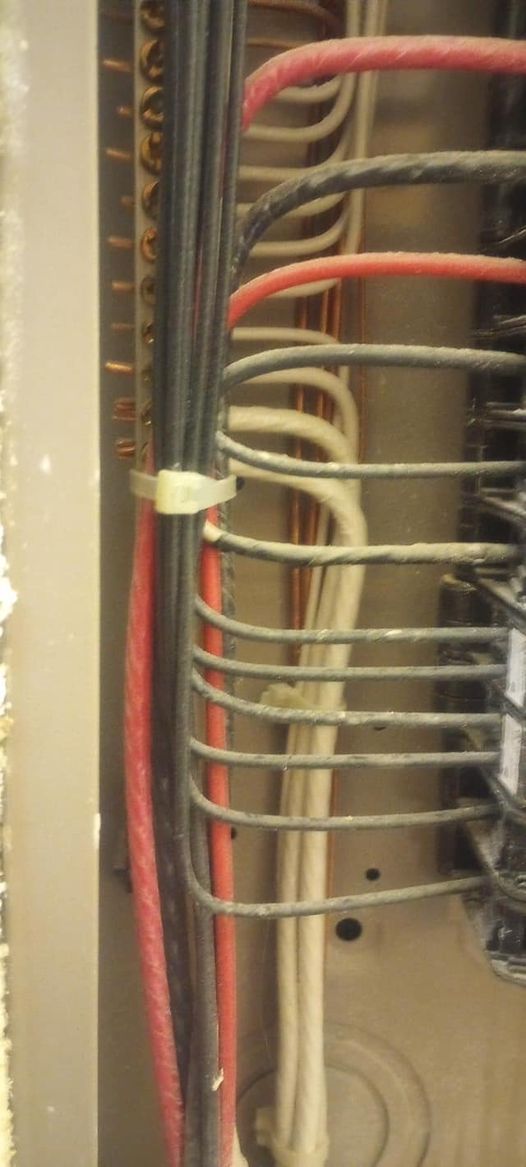Is a bad ground or neutral causing 47 volts to backfeed through my cable, despite not registering on my multimeter, and should I be concerned about tightly zip tied hot wires in my breaker panel?
11 months ago
Last Updated: July 26, 2024
Hey, so I’m dealing with some house issues – the cable guy mentioned there’s 47 volts back feeding through the cable. I tried using a regular multimeter but didn’t get any voltage readings. He thinks there might be a bad ground or neutral somewhere, but I couldn’t find anything. I did notice something in the breaker panel – the hot wires are tightly zip tied against the ground rail. It might not be a big deal, but I’d love to hear the opinion of someone more knowledgeable. What do you think?

Double-check for any water leaks near the connections or any humidity buildup… Also, if you can, unzip it to investigate the source of grounding…
You’re giving the same responses as when you first posted this.
That is not an issue.
It’s possible that the cable is positioned very near a hot wire and induction is happening… communication lines and wires don’t go well together in the same vicinity. Just something to consider.
Did the cable guy actually demonstrate the readings or are you just trusting his word?
Watching someone get shocked by static discharge at a light switch is quite the sight.
I was advised against running cables or data wires close to high voltage (just a suggestion)😊
If you’re in my area, I can recommend an experienced electrician to hire.
You seem to have a floating ground. Make sure to check all your grounding points.
Hold on, is the cable guy also an electrician? How did he figure out there’s 47V on the cable?
Use a low impedance meter. Then meter the cable where he claims he measured it. If it’s present, unplug the cable box(es) then measure again. If it persists, break the cable at the demarc at the side of the house. If it still persists, you have a real issue.
I think it will go away when you unplug the cable boxes because it’s likely a faulty cable box putting too much voltage on the coax.
Does his system also include a grounding point?
Can you share how and where he managed to get 47 volts? Maybe snap a pic of that
The integrity of the neutral coming into the house is compromised.
A neutral on a Transformer in the cable box or router might be causing a faster power source.
It’s just induced voltage on the cable, no big deal if he used the proper termination technique at the service entrance to the house, it would disappear. It’s fine for the sheath to be grounded, I actually believe it should be. Maybe some TV cable installers can verify that or refute it.
Rounding is crucial for safety and proper functioning.
Weak round……………
One of the most crucial aspects of …………….
You can keep saying it’s a ground issue all you want, but I’m not buying it.
8 FOOT ROUND STAKE…………⚡⚡⚡⚡⚡⚡⚡⚡⚡⚡⚡⚡⚡
Did you not receive a response the other day when you posted the same question?
Connect your neutrals and grounds together and ground rod outside and in your panel. Try this and remove the zeptie.
Plagiarized post and re-posted. Scammer.
Seriously, who in their right mind would attach hot wires to a ground bar? That’s just plain stupid. But hey, not your problem.
Make sure your D-mark outside is grounded properly first! Also, never let your coax (R-6) and LV cables run parallel less than 2′ apart and no longer than 6′. Learned that lesson the hard way back when we didn’t care about other subcontractors.
Is all bonded up!
Avoid the panel, the issue is not located there – even though there are other concerns present.
Is the demarcation point bonded to the grounding electrode, or did they simply insert a green wire into the ground?
I’ve noticed that people often neglect to properly ground their systems. I’d say that’s a good place to begin.
Check out your grounding electrode system. I remember this one customer who ended up frying all his TVs at home because he decided to cut the grounding electrode, thinking it was unsightly.
A loose neutral connection could be anywhere from a junction box under the house to the electrical panel. Even a receptacle could be the culprit.
🤷🏻♂️
How many times do you plan on posting this?
If it was knob and tube and rewired, they could have the neutral and hot reversed.
If you suspect a loose or faulty neutral, try adding more load to the circuit and see if the voltage increases.